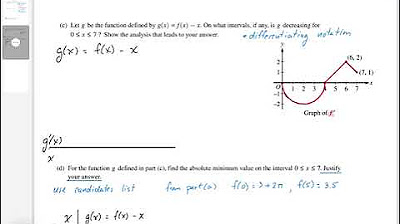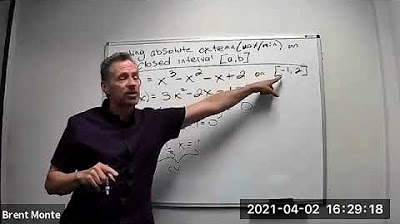2011 Calculus AB free response #4b | AP Calculus AB | Khan Academy
TLDRThe video script discusses the process of determining the x-coordinate of the absolute maximum of a function g on a given interval. The explanation begins with a general overview of how to find the absolute maximum on an interval, considering various scenarios where the maximum could occur. The function g is derived from another function f, and the video demonstrates evaluating g at the interval's endpoints and any critical points within the interval. By analyzing the derivative of g and solving for when it equals zero, the critical point at x=5/2 is identified where g reaches its absolute maximum on the interval from -4 to 3.
Takeaways
- 📈 The task is to find the x-coordinate where a function g has an absolute maximum on a given interval [-4, 3].
- 🔍 To solve this, one must evaluate g at the endpoints and any critical points within the interval.
- 🤔 The absolute maximum could occur at the start, end, or at a critical point within the interval.
- 🧐 The function g is derived from another function f, and its critical points may not always be points of differentiability.
- 📌 The process involves evaluating g at -4 and 3, and checking for critical points in between.
- 📊 For g(-4), the value is negative, calculated using the integral of the function f over the interval [0, -4].
- 📈 At the endpoint g(3), the function value is positive, with the integral from 0 to 3 cancelling out due to symmetry.
- 🌟 The derivative of g, g'(x), is found by differentiating the expression of g and checking for points where g'(x) = 0.
- 🔢 The function f is linear in the interval of interest, with a slope of -2, leading to the equation -2x + 3 = -2.
- 🎯 The x-coordinate of the critical point is found to be 5/2 by solving the equation for x.
- 🥇 The absolute maximum of g on the interval [-4, 3] occurs at x = 5/2, with a value of 6.25 (or 5/4).
Q & A
What is the main topic of the video script?
-The main topic of the video script is to determine the x-coordinate of the point at which the function g has an absolute maximum on the interval from negative 4 to 3.
How does the speaker initially approach the problem?
-The speaker initially approaches the problem by thinking in general terms about a function over an interval where it could have an absolute maximum, and then draws axes to visualize the situation.
What are the different scenarios the speaker considers for the function's absolute maximum?
-The speaker considers three different scenarios for the function's absolute maximum: the maximum occurring at the beginning of the interval, at the end of the interval, or at a critical point within the interval.
How does the speaker evaluate the function g at the endpoints of the interval?
-The speaker evaluates the function g at the endpoints by calculating g(-4) and g(3) using the given function definition and integration.
What is the result of evaluating g at the starting point (-4)?
-The result of evaluating g at the starting point (-4) is a negative number, specifically -8 - 2π.
What is the result of evaluating g at the end point (3)?
-The result of evaluating g at the end point (3) is a positive value, which is 6.
How does the speaker determine the critical points within the interval?
-The speaker determines the critical points within the interval by finding where the derivative of g, g'(x), is equal to 0 or by identifying points where the function is not differentiable.
What is the equation of the function f(x) that the speaker identifies as being relevant to the problem?
-The equation of the function f(x) that the speaker identifies is y = -2x + 3, which is relevant for determining the critical points of g(x).
What x-value satisfies f(x) = -2?
-The x-value that satisfies f(x) = -2 is x = 5/2.
What is the final answer for the x-coordinate of the absolute maximum of g on the interval?
-The final answer for the x-coordinate of the absolute maximum of g on the interval is x = 5/2.
How does the speaker confirm that the critical point at x = 5/2 is indeed the point of absolute maximum?
-The speaker confirms that the critical point at x = 5/2 is the point of absolute maximum by evaluating g(x) at this point and comparing it with the values of g at the endpoints, finding that g(5/2) > g(-4) and g(5/2) > g(3).
Outlines
📊 Determining Absolute Maximum and Critical Points
This paragraph introduces the problem of finding the x-coordinate of the absolute maximum of a function g on a given interval, and sets the stage for the analysis. The speaker begins by discussing the general concept of absolute maximums on an interval and illustrates this with a graphical representation of different possible functions. The focus is on evaluating the function g at the interval's endpoints and checking for critical points within the interval. The speaker calculates g(-4) and explains the process of evaluating the integral part of the function, which involves understanding the area under the curve and accounting for negative areas. The result is g(-4) = -8 - 2π, indicating a negative value.
📈 Evaluating Endpoints and Differentiability
In this paragraph, the speaker continues the analysis by evaluating g at the other endpoint of the interval, x=3. The calculation leads to g(3) = 6, which is a positive value, contrasting with the negative value found at the starting point. The speaker then discusses the differentiability of g and uses the fundamental theorem of calculus to find its derivative, g'(x) = 2 + f(x). It is determined that g is differentiable throughout the interval, and the next step is to find any critical points by setting the derivative equal to zero. The speaker visually identifies a point where f(x) = -2 and calculates the x-value to be 5/2.
🔢 Critical Point Evaluation and Absolute Maximum Determination
The final paragraph focuses on evaluating the function g at the critical point x=5/2, which is suspected to be a potential maximum due to the derivative being zero at this point. The speaker calculates g(5/2) using the integral of the function's derivative and the value of the function at the critical point. After solving the integral and performing the evaluation, the result is g(5/2) = 6.25, which is higher than the values of g at both endpoints. This confirms that the x-coordinate of the absolute maximum of g on the interval is indeed 5/2, providing a conclusion to the analysis.
Mindmap
Keywords
💡Absolute Maximum
💡Interval
💡Critical Point
💡Derivative
💡Integration
💡Slope
💡Antiderivative
💡Area
💡Differentiable
💡Endpoint
💡Global Maximum
Highlights
The problem involves finding the x-coordinate where a function g has an absolute maximum on a given interval.
The interval in question is from negative 4 to 3.
The function g is derived from another function f.
The absolute maximum of a function can occur at the beginning, end, or a critical point within the interval.
To find the absolute maximum, evaluate g at the endpoints and any critical points within the interval.
The evaluation of g at negative 4 results in a negative value, indicating it is not the absolute maximum.
The evaluation of g at 3 yields a positive value, suggesting it could be the absolute maximum.
The derivative of g is calculated to find critical points.
It is determined that g is differentiable over the entire interval, which simplifies the search for critical points.
Setting the derivative equal to zero leads to finding the x-value where f(x) is negative 2.
The x-value of 5/2 is found where f(x) equals negative 2.
The evaluation of g at the critical point 5/2 results in a value higher than the endpoints, indicating it is the absolute maximum.
The process involves visual analysis and the use of calculus principles, such as the fundamental theorem of calculus.
The problem-solving approach combines algebraic manipulation with geometric interpretation.
The solution requires a combination of evaluating integrals and understanding the behavior of the function.
The final answer identifies the x-coordinate of the absolute maximum as 5/2.
Transcripts
Browse More Related Video

Absolute Maximum and Minimum Values - Finding absolute MAX & MIN of Functions - Calculus

2022 AP Calculus AB BC Free Response #3

2016 AP Calculus AB Free Response #3

AP CALCULUS AB 2022 Exam Full Solution FRQ#3(c,d)

Finding Absolute Extrema (Max/Min) on a Closed Interval [a, b]

Justification with the intermediate value theorem: equation | AP Calculus AB | Khan Academy
5.0 / 5 (0 votes)
Thanks for rating: